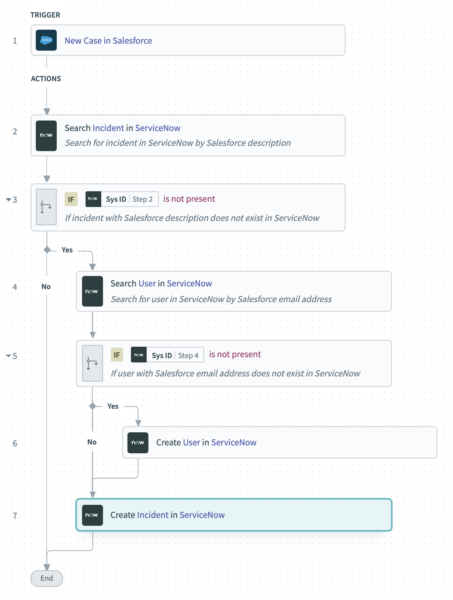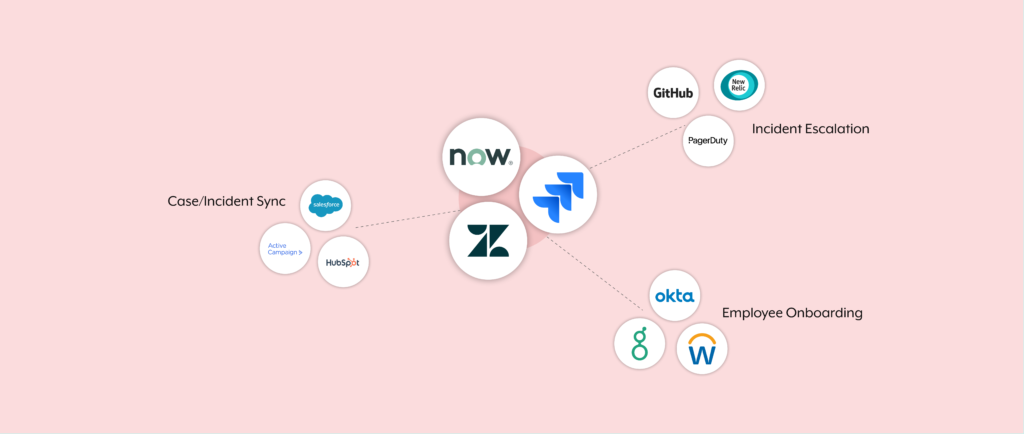IT service management is essential in providing a high-quality experience for clients and employees.
It defines your approach to providing employees the apps and equipment they need, when they need them; it lays out the system your organization uses in managing issues on behalf of employees and clients; it illustrates how you deliver self-service information to employees and clients—and a whole lot more.
To bring these processes to life, you’d use an IT service management tool, or ITSM tool for short.
We’ll highlight all of the ways you can use this tool on behalf of end users (employees and clients), and we’ll dive into the role automation plays in optimizing its value. That way, you’ll be able to fully leverage the tool across your technology and teams.
1. ITSM tool use cases
2. ITSM integration definition
3. Examples of ITSM integration
4. Benefits of ITSM integration
Related: What is service desk automation? Here’s what you need to know
What is an ITSM tool used for?
An ITSM tool helps IT carry out a broad set of tasks across their organization, which can fall under any of the following:
- Incident management: It’s the end-to-end workflow for addressing specific issues. An incident can be as minor as a malfunctioning printer or as significant as a product bug that impacts customers.
- Problem management: Similar to incident management, problem management is the end-to-end process of solving an issue. The difference here, however, is that you’re trying to solve the underlying issue that’s causing the incident(s)—in the hopes of preventing them from occurring in the future.
- Knowledge management: It involves creating, categorizing, storing, and sharing information in the ITSM system. This allows both employees and customers to find the answers to their questions independently and quickly.
- Request management: It enables employees and customers to make specific requests, whether it’s for a product or it’s simply an answer to their question.
- Asset management: It’s the management of hardware, software, and cloud assets so that IT can minimize risk while still providing the team with the equipment and technology they need to be productive.
- Change management: It allows you to roll out changes to your IT infrastructure in a way that’s fast, traceable, and that causes minimal disruptions to your systems.
- Configuration management: It tracks all of the IT assets used in delivering services as well as the relationship each of these assets have with one another.
With these use cases in mind, let’s start exploring the role integration plays in helping you get more out of the tool.
What is ITSM integration?
It’s the process of connecting your ITSM platform with other apps through a 3rd-party tool that uses their application programming interfaces (APIs). Once connected, the apps can be kept in sync whenever an event or data changes in one of them.
It’s important to note that the applications of ITSM integration extend beyond data syncing. Once integrated, you can also go on to implement end-to-end workflow automations that can fulfill a given process seamlessly (we’ll go over one in the following section).
Related: What is CRM integration?
Examples of ITSM integration
Here are 3 common use cases to consider, with the first being a data sync, the second being a workflow automation, and the third being somewhat of a hybrid of the two.
Note: These examples all use ServiceNow as the ITSM tool. You can easily replace it with alternative options, like Jira or Zendesk, when implementing these workflows.
1. Sync your ITSM with your engineers’ ticket management system to get their support when needed
As your organization experiences more technical issues, it’s critical that your engineers become aware of them and can work to resolve any quickly.
To help them, you can integrate the tool they use to manage issues—like GitHub—with an ITSM platform like ServiceNow. From there, you can build the following ticketing workflow:

1. An incident is marked as escalated in the ITSM tool.
2. This creates a corresponding issue in a tool like GitHub in real time. The GitHub issue includes key info from the incident, such as the name of the client, the description of the issue, the date it occured, etc.
2. Integrate your ITSM with your HRIS, ATS, and access management platform to streamline employee onboarding
To give new hires a positive first impression of your organization, and to help them hit the ground running, you can provide them with all the apps and equipment they need on day 1.
This involves connecting your ITSM with an HRIS like Workday, an ATS like Greenhouse, and an identity and access management platform like Okta. You can then implement a workflow automation that does the following:
1. Once a candidate is marked as hired in Greenhouse, the workflow gets triggered.
2. The new hire is set up in Okta and Workday.
3. The new hire receives an email—which you can easily customize in advance—that’s scheduled for their first day.
4. The new hire gets added to the ITSM, and tickets related to onboarding them get created.
Related: A guide to automating employee onboarding
3. Connect your ITSM with your CRM to help customer-facing employees flag issues quickly
Given the close relationship your customer success managers have with clients, they’re often the first ones to be alerted of any issues when they arise.
You can allow them to point out any as soon as they’re aware of it so that their colleagues can work on resolving it quickly. This simply involves connecting a CRM like Salesforce with your ITSM and then implementing a workflow that operates as follows:

1. Your customer success manager creates a case for a client in the CRM.
2. If the case’s description is found in an incident in ServiceNow, nothing happens (this implies that the incident already exists). If it isn’t found, the workflow continues.
3. If the user (client) in ServiceNow doesn’t exist, they’re created in ServiceNow.
4. The incident gets created in ServiceNow, and it includes key fields from the case, such as its description, date created, etc.
Benefits of ITSM integration
Given all of its use cases, ITSM integration offers a variety of benefits.
- It removes data silos, where data is locked in specific apps that only select employees can access.
Data silos can cause all kinds of issues. Employees may experience delays after requesting data; they may spend a frustrating amount of time requesting and looking for data; and they may even be unaware that certain data exists, which prevents them from ever using it.
ITSM integration can knock down these silos and solve the negative consequences they created, as it allows employees to receive the data they need from your ITSM within the apps they’re using.
- It enhances the customer experience. By working cross-functionally on client issues effectively, your team can consistently minimize its time-to-resolution. This translates to happier clients who are more likely to keep working with your organization over time.
- It improves the employee experience. Your new hires receive a better onboarding experience, as they’re able to get the resources they need from the get-go; and employees can avoid tedious tasks, like app hopping and data entry, as they only need to perform an action in a single app once.
- It minimizes costly human errors. Performing extensive data entry leaves your organization vulnerable to all kinds of issues that can impact clients and employees. Incidents can be accidentally assigned to the wrong colleague; new hires can get provisioned with the wrong set of apps and equipment; employees can move slowly in escalating an issue—and the list goes on.
Integrating your ITSM with other apps prevents issues like these from bubbling up, as it allows you to streamline error-prone tasks across your apps.
- It paves the way for digital transformation. Once your apps are integrated, you can implement end-to-end automations across your apps, teams, and data that can fundamentally transform the way your business operates. This applies to all kinds of processes in HR, finance, sales, marketing, support, and IT.
Related: The benefits of automating your help desk
Implement powerful ITSM integrations and automations with Workato
Workato, the leader in integration-led automation, offers a low-code/no-code platform for integrating your apps, databases, legacy systems, etc. AND automating your workflows end-to-end.
Here’s more on the platform:
- It provides connectivity to 1000+ apps via pre-built connectors and it allows you to use customizable automation templates (“recipes”) so that your team can automate at scale, quickly
- It offers a built-in bot framework, which lets your employees work in their apps and automate their workflows within their business communications platform
- It offers enterprise-grade security and governance so that all of the data in your apps are kept secure and in the right hands
You can learn more about Workato and how it can help you get the most out of your ITSM tool by connecting with an automation expert.
